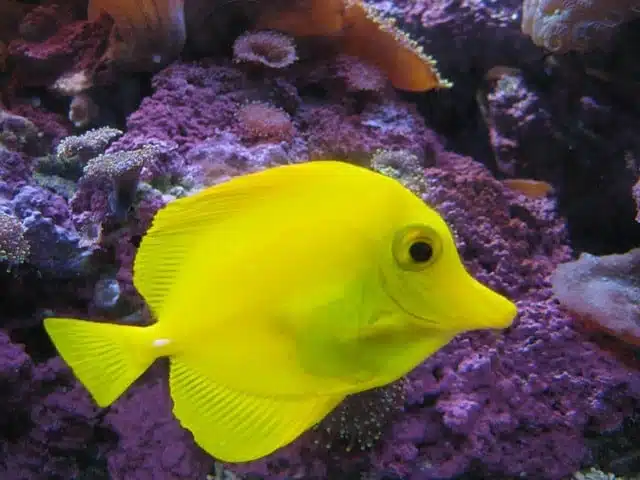Coming across yellow animals in everyday life is exceedingly rare. Perhaps this is because many of the creatures Mother Nature has blessed with this vivid and fascinating color mainly inhabit the wild and are less domesticated.
Still, if you’re adventurous enough, you’ll probably come across some of the creatures we’ll discuss in this article at least once in your lifetime, if not frequently.
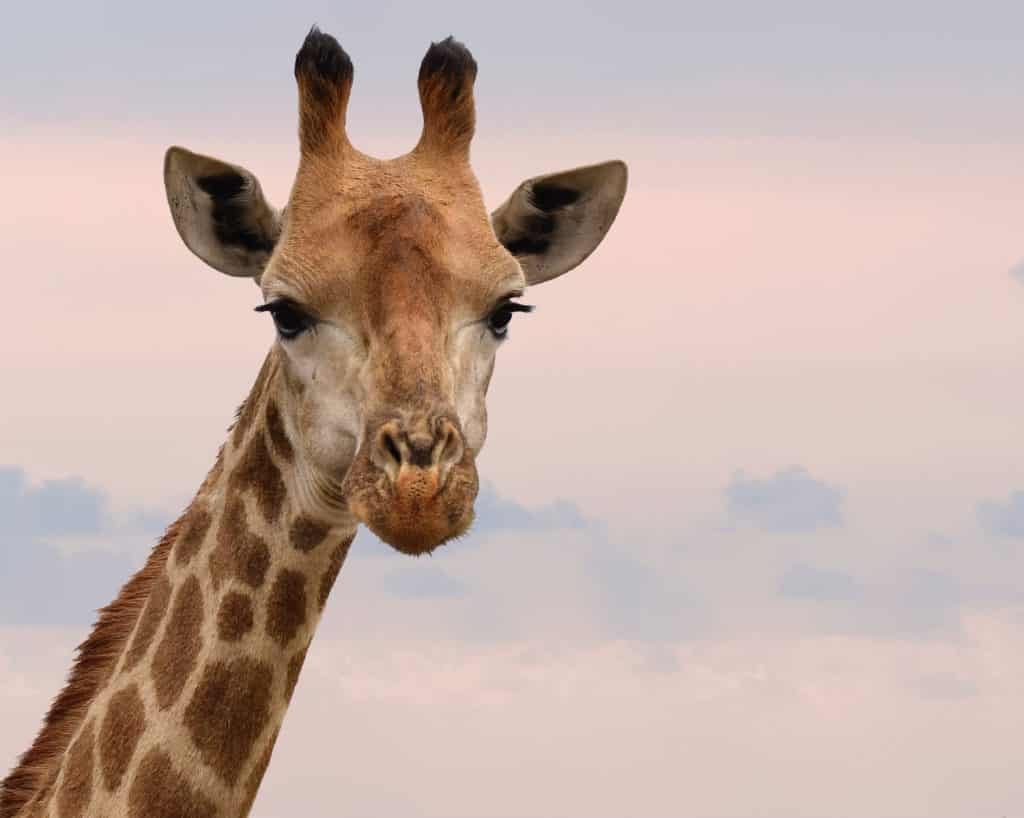
However, many animals don’t wear their golden colors to look beautiful or attract mates. In short, a fair number of them use their colors to warn potential predators that they are venomous or use them to camouflage when hunting prey.
For many of these animals, their color serves a greater purpose as an essential aspect of survival. Now let’s run down a list of the top 10 most stunning yellow animals.
10. The American Goldfinch (Spinus tristis)
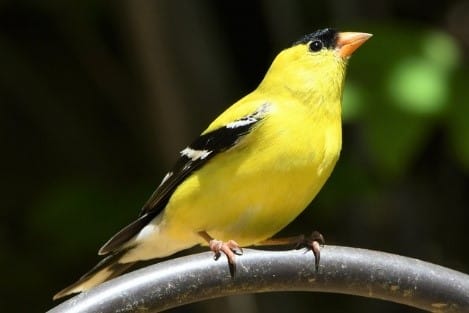
Almost exclusively a vegetarian feeder, the American goldfinch is a migratory bird predominantly that lives in gardens, floodplains, and weedy fields throughout North America.
During winter, these birds travel across stretches of the North American continent to warmer climates in southern Canada, south to parts of Mexico, to find open fields where they can feed on seeds and nuts.
The goldfinch’s migratory habit is also a result of the seasons in that their plumage also changes as the seasons change.
They maintain bright yellow feathers with black patches from spring through summer, then shed off their bright feathers for an olive-green plumage for the winter months.
This seasonal change of colors from a bright yellow animal to a darker olive-green animal is an adaptation that helps to attract mates during the breeding summer months and detract predators during winter, when their vivid hue may call attention to them.
Another peculiar aspect of this bird’s lifestyle is its undulating flight mode. The goldfinch flies in almost a zigzag pattern, perhaps most noticeable when they are trying to court a mate.
9. Galapagos Land Iguana (Conolophus subcristatus)
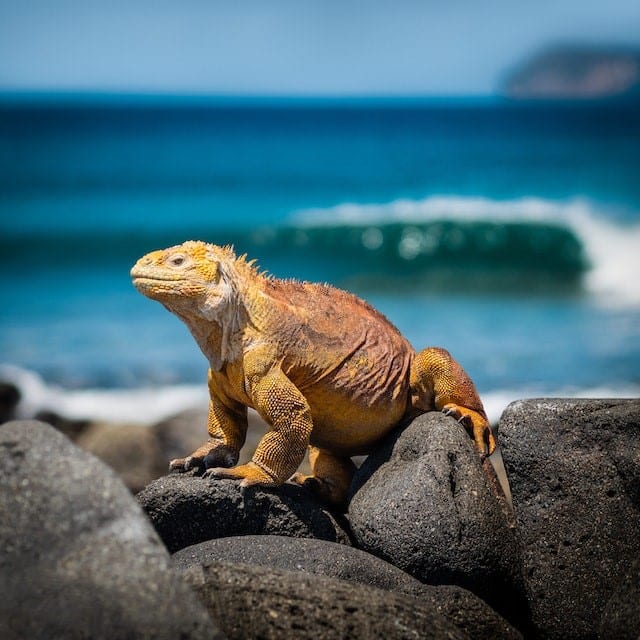
As the name suggests, this solitary reptile is native only to the volcanic islands of the Galapagos in Ecuador, and it is one of the four iguana species endemic to this region.
The male land iguana is easily distinguishable from other iguana species by its yellow skin, which may have black, brown, and white blotches.
They don’t reach sexual maturity until they are at least 8 to 15 years and have an expected lifespan of around 60 to 70.
Being cold-blooded, the Galapagos land iguana spends most of its days in the sun basking on volcanic rocks, and it will retreat into its burrows at night to conserve body heat.
Because of the scarcity of freshwater in island habitats, it obtains most of its water from feeding on prickly pear cactus, which makes up a significant part of its diet.
Besides its herbivorous feeding habits, the land iguana can sometimes be an opportunistic carnivore as they also feed on small centipedes and scavenge carrion if the chance arises.
8. Eyelash Viper (Bothriechis schlegelii)
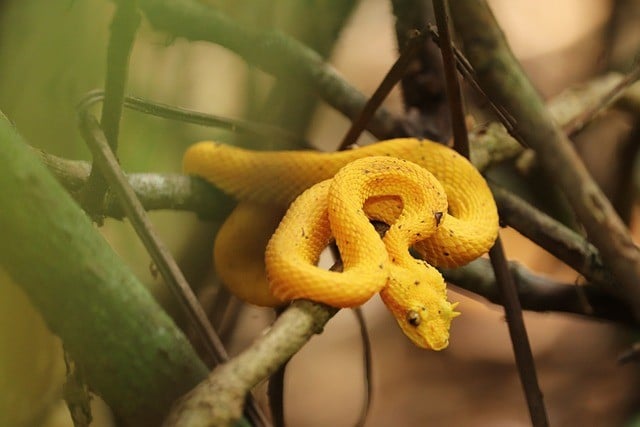
The Eyelash Viper gets its name from the modified scales above its eyes that look like horns, which gives it the appearance of having an eyelash.
The snake is a venomous pit viper that primarily lives in the humid and tropical forests of North, South, and Central America, from Mexico down to Panama, Colombia, and Peru.
It grows up to 60 to 85cm in length. It prefers hanging around in trees with dense foliage where it can easily camouflage with its color and lay ambush for unsuspecting prey such as small birds, frogs, rodents, and other sizable mammals.
The eyelash viper is nocturnal, and it is one of the few snake species with an ovoviviparous mode of reproduction.
This means its female carries around the eggs of their young for about six months before hatching them internally and giving birth to live snakelets which look much like the adult.
At any rate, if you ever come across a horned Viper, don’t let the attractive colors of this yellow animal fool you. Its venom is highly haemotoxic and neurotoxin, and it can gravely affect the cardiovascular and central nervous system, even in humans.
7. Yellow Seahorse (Hippocampus kuda)
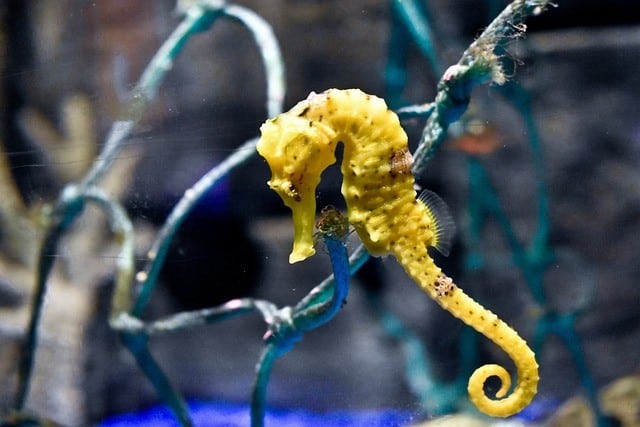
Also known as the common seahorse or estuary seahorse, the yellow seahorse is arguably the most prevalent animal in this list.
H. kuda is a native specie in over 23 countries ranging from South Africa, Australia, and Japan, to many Southeast Asian countries. Here, they commonly live in estuaries, harbors, lagoons, seagrass beds, and shallow waters of the Pacific Ocean.
They are a monogamous species and engage in a flamboyant courtship ritual before mating. Furthermore, this marine wonder has a unique reproductive system where the males carry the young for the duration of gestation.
The common seahorse is famous in aquariums because it adapts well to slow-moving currents and ambient environmental conditions. Although it still exists in large populations around Australia and Indonesia, the yellow seahorse is a vulnerable species.
The reduction in their population size has been mainly due to hunting and bycatch from shrimp trawl fishing.
6. Golden Poison Frog (Phyllobates terribilis)
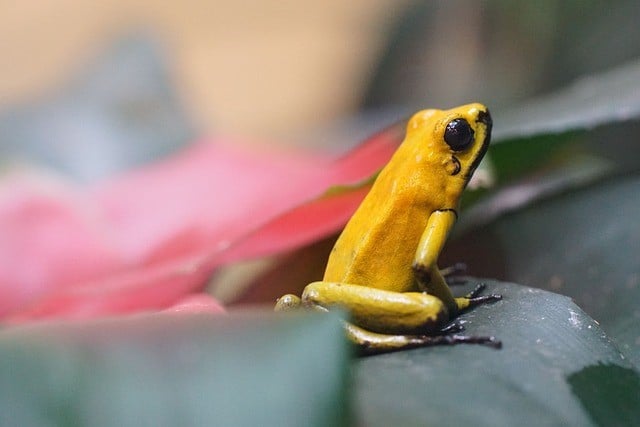
Yellow hasn’t always been synonymous with danger, but this is the second highly toxic yellow animal on this list, so it’s fair to assume not all that glows amber is safe.
In the case of the golden poison frog, it uses its flashy colors to ward off predators rather than attract prey. Sometimes referred to as the golden dart frog or the poison arrow frog, this amphibian is endemic only to Colombia’s rainforest and Pacific coasts. They thrive best in arboreal habitats with temperate weather and relative humidity in the 90th percentile.
Although it measures only 1-2 inches, it is still one of the most poisonous animals on earth because of the batrachotoxin it secretes from its skin. The poison is so toxic that only one milligram could kill up to twenty humans, and you can be in grave danger just by holding the frog with your bare hands.
However, it is interesting that the poison dart frog doesn’t create these lethal toxins by itself. It accumulates the potent toxic alkaloids from feeding on venomous insects and vermin.
Sadly, because of their limited habitat distribution, this animal is listed as an endangered specie. Fortunately, conservation efforts are being in place to reverse their population decline.
5. Banana Slug (Ariolimax californicus)
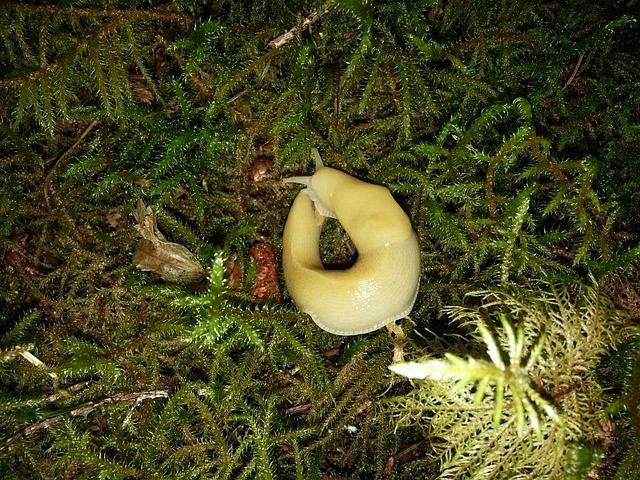
The banana slug is a mollusk that gets its name from its form and shape, which looks much like a ripe banana.
They are endemic to the North American Pacific Coast, where they live on dense forest floors ranging from Alaska to central California. Banana slugs are the second largest land slug species, and they can grow up to 10 inches while weighing over 4 ounces.
Although banana slugs are hermaphrodites possessing both male and female sex organs, they sometimes reproduce by mating with other individuals in their species.
They release a very potent slime across their body which serves multiple purposes;
- It helps them stay moist and avoid dehydration.
- They use it to glide along the forest floors during movement.
- It also protects them from predators because of its numbing effect, which can numb a predator’s tongue when they try to consume them.
Because of these slime’s peculiar properties, scientists have studied it as an alternative surgical adhesive that can bond to bloody tissue.
Notably, the banana slug is the official mascot of the University of Santa Cruz, California.
4. Yellow Tang (Zebrasoma flavescens)
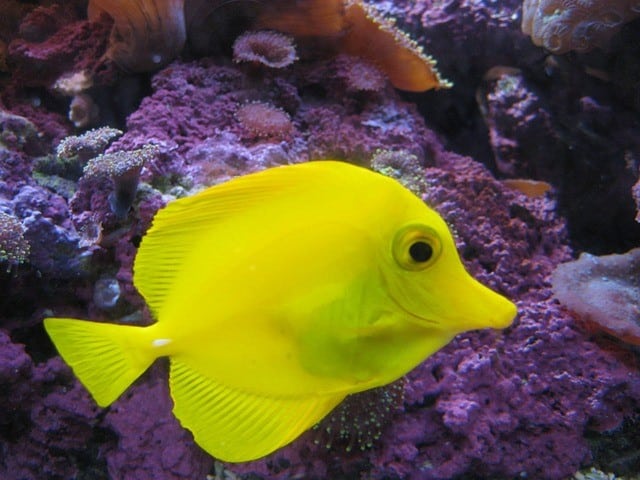
The Yellow Tang is a fish species native to the shallow tropical reefs of the Pacific Ocean. These yellow animals are found in the coastal waters of Hawaii, Japan, and many island countries across the southern Pacific.
They have also reported sightings of the yellow tang along the Florida coastline, a habitat it is not native to. An adult yellow tang can only grow up to 20cm long and 2cm thick, but it can live up to 30 years in the wild. In captivity, this life expectancy is reduced to 5 to 10 years.
Their longevity and pronounced yellow color are perhaps why they are a popular feature of many aquariums worldwide. Surprisingly, the yellow tang doesn’t always maintain its vivid colors at all times.
It appears bright yellow during the day, but this color fades to a grayish yellow with white lateral stripes during the night.
In addition, this creature is also sensitive to the lunar cycle, only spawning their eggs when there is a full moon. In the wild, they are mainly herbivores, feeding on algae and other plant material. However, in captivity, they are also commonly fed meat and fish-based.
The efficacy of this has been questioned, as yellow tangs fed on animal-based diets in aquariums risk losing their bright colors over time.
3. The 22-Spot Ladybird (Psyllobora vigintiduopunctata)
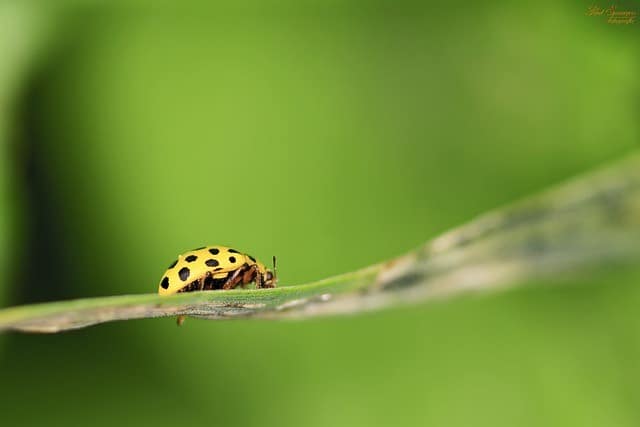
This small European beetle is so named because of the black spots on its wing cases which are exactly twenty-two in number, though it also has 4-5 dark spots on its head (protonum).
Because of this, some have made a case for it being called the 26-spot ladybird. Nevertheless, its identifiable number of dark spots makes it easily distinguishable from other ladybird species.
The 22-spot ladybird only grows 3 to 5mm long and is native to the UK and many countries across Western Europe. Here, it is commonly found among low-growing vegetation like gardens and meadows, feeding on mildew and other fungi.
This singular characteristic sets it apart from other ladybird species. Ladybirds typically favor habitats on tall grasses and flowers where they can feed on nectar, honey, aphids, and small insects.
2. Eurasian Golden Oriole (Oriolus oriolus)
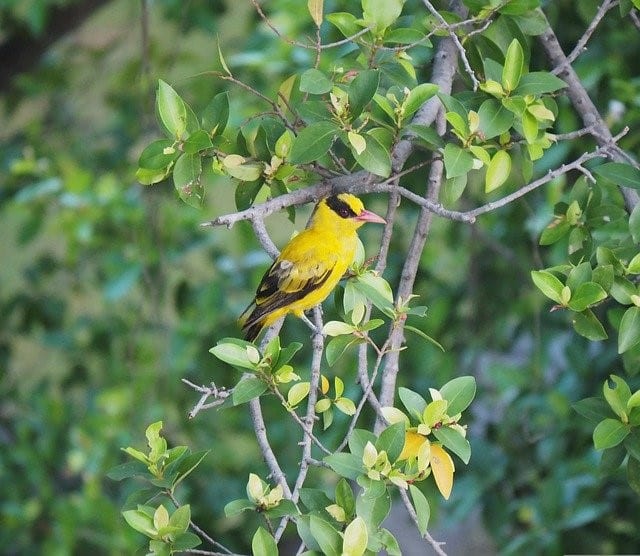
The Eurasian golden oriole is a shy songbird that gets its name from its favored spring and summer habitats.
Although these birds’ journey across the Mediterranean to temperate regions in Central and South Africa before winter, during the warmer months, their breeding grounds typically span from Western Europe and Scandinavia to China and East Asia.
In this region, they are commonly found inhabiting open plantations, orchards, and coniferous forests. When they migrate south during autumn, they are found in wet woodlands, savannahs, and riverine forests across Sub-Sahara Africa.
Their feeding habit is omnivorous, as they mainly feed on insects, fruits, seeds, and nectar.
Despite their colorful plumage, it is often difficult to spot these birds when they are in the trees because of their secretive habits. However, you can quickly identify their presence by their unmistakable bird songs.
The oriole is a golden-yellow animal with distinct black wings and red beaks, though the female members of this species have a more greenish color with whitish-yellow underbellies.
They are monogamous and typically form lasting pair bonds with mates. Similarly, males and females play a part in nest building, egg incubation, and providing for their offspring. Their eggs hatch within two weeks, and adults can grow up to 25cm with a lifespan of up to 10 years.
1. Goldenrod Crab Spider (Misumena vatia)
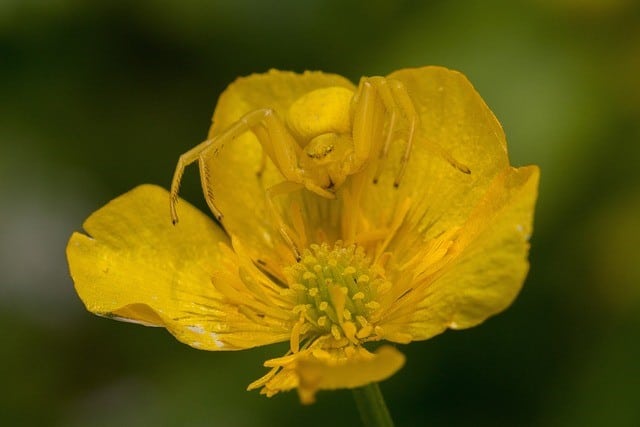
Only found in habitats across the northern hemisphere, this arachnid is arguably the most interesting yellow animal described in this article. Perhaps that is a bold claim to make, but don’t just take our word for it; look at these unique characteristics of the golden crab spider.
Firstly, unlike many spiders, M. vatia doesn’t spin its webs to ambush prey when hunting. Instead, it lays an ambush for prey on yellow or white flowers like the golden rod flower [hence the name], where it can easily use its colors to camouflage and inject deadly venom once the creature is in close range.
Secondly, the female golden crab only uses its webs during reproduction to protect its eggs from predators. She spins her webs to cover her offspring in nest leaves, then guides the nest until the eggs have hatched, after which she dies.
Thirdly is the crab-like motion with which these spiders move. They can walk sideways, forwards and backward like a crab, thus their hallmark moniker as crab spiders.
Crab spiders only grow up to 10mm, and although they are venomous, they are not dangerous to humans because their venom is too weak to kill large animals, and their fangs can’t penetrate human skin.
Another thing to note is that crab spiders are not always yellow. Their color mainly alternates between yellow and white for camouflage because they prefer daisies and goldenrod flowers, typically white and yellow.
Summary of the most stunning yellow animals
And that completes this fun rundown of the most memorable yellow animals. We hope you had an adventure.
You can have even more fun by looking at our exciting category of articles about Orange Animals or 10 Black Animals.
Join our Forum for free today!

- These are The 5 Largest Great White Sharks Ever Recorded - July 19, 2024
- The Surprising Benefits of Big Game Hunting - July 18, 2024
- $100k+ Hunting Experiences The Most Expensive Animals to Pursue - July 17, 2024

